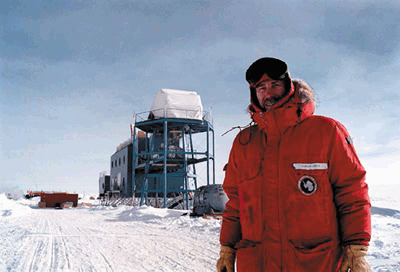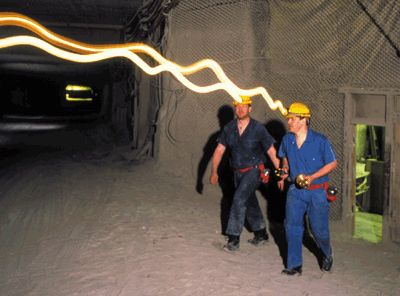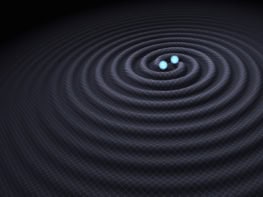Frost bite, no toilets and polar bears – these are some of the hazards that physicists face when working in hostile environments. But, as Paula Gould reports, they seem to enjoy it.

When Neil Spooner, a physicist at Sheffield University in the UK, goes to work, he heads for his office on the ground floor of the Hicks building on the main university campus. When he wants to check on his experiment, however, he must get into his car, drive for two hours and then take a lift that descends 1100 metres underground. On leaving the lift he has to walk for a kilometre in temperatures of up to 40 °C to reach his laboratory. He must bring food and water with him and he won’t see a toilet for another eight hours.
A working salt and potash mine is not the most conventional location for a research laboratory. Yet Spooner and his colleagues in the UK Dark Matter Collaboration (UKDMC) have found the mine at Boulby in North Yorkshire, which is owned by Cleveland Potash Ltd, to be ideally suited to their search for the “dark matter” that is thought to account for more than half of the matter in the universe. Most dark-matter experiments are performed deep underground to shield the detectors from cosmic rays.
Dark days
Dark matter has been proposed by astronomers to explain certain features of the universe, such as the fact that galaxies rotate faster than can be explained by the amount of visible matter that they contain. Some dark matter is thought to exist in the form of ordinary matter that does not “shine”, but many physicists believe that a significant fraction of it comes in the form of new particles, such as weakly interacting massive particles (WIMPs). However, these particles are extremely difficult to detect – if they exist at all – because they only interact very weakly with conventional matter. It is therefore necessary to house dark-matter detectors deep underground to shield them from cosmic rays, which can mimic the WIMPs (see The search for dark matter by Nigel Smith and Neil Spooner in Physics World January 2000 pp23-28).
“The dark-matter problem is a fundamental problem, and if you want to solve it, you are forced to go underground,” says Spooner. “There are other sites around the world that are probably better for these experiments, but in terms of convenience and cost, it was better for us to go to Boulby. Apart from being deep, the salt rock is very low in radioactivity, which produces a better site for experiments.” Other physics experiments housed in mines include the SuperKamiokande neutrino experiment, which is located in a 1000 m deep lead and zinc mine in Japan, and the Sudbury Neutrino Observatory, which was built 2000 m underground in a nickel mine in Canada.
As the Boulby mine is fully operational, the hunt for dark matter has to fit in with the shift-patterns of the 1000 or so miners who spend their days (and sometimes nights) underground. The researchers tend to hitch a ride on the lift going down at 8 am in the morning, and return to the surface with the shift finishing at 4 pm in the afternoon. For safety reasons, the physicists generally work in pairs, and no-one is left alone without prior authorization.
Nigel Smith, who leads the Rutherford Appleton Laboratory’s involvement in the UKDMC, spends a week underground at Boulby every two or three months. Conditions can be “pretty rough” according to Smith. “We have to air condition as best we can. We try and keep the temperatures down to about 28 °C, which is tolerable,” he says. “One of the key things underground is that you must be able to sweat, which surprisingly not everybody can.”
Like many researchers, Smith thrives on the stresses inherent in working in an unusual location. “It makes it much more of a challenge, to get the experiment to work, to get the team to work together well, and to get the best out of yourself,” he says.
“Working in a mine is not like many people imagine a mine to be, crawling through holes, and so on,” adds Spooner. “Obviously there are no windows or anything, but there is lots of space and the labs are lit well. Basically once you’re there, it’s just like working in any other lab.” The collaboration plans to open new laboratories at Boulby – both above and below ground – later this year, paid for by a £3.8m grant from the government’s Joint Infrastructure Fund.
Physics on ice
Nigel Smith has also experienced the difficulties of doing physics in a completely different and even more extreme environment – the South Pole. Being so near to the Earth’s axis, experiments at the South Pole enjoy uninterrupted views of certain parts of the sky. This is crucial for many types of astrophysical observations, such as measurements of the cosmic background radiation. The skies above the Antarctic plateau are also very clear at infrared, microwave and sub-millimetre wavelengths because the air is dry and cold.
Smith made his first visit to the pole in the mid-1980s as a PhD student at Leeds University researching the enemy of dark-matter experiments – cosmic rays – and later spent a complete year there, during which time he experienced the full severity of an austral winter. “The temperature at the pole in the summer can rise as high as 15 below zero,” Smith says. “During the winter it’s a pretty standard 60 °C below.”

In common with all personnel who spend time at the pole, he had to undergo a full medical examination to check he was physically capable of enduring the polar environment. He also had to take psychological tests similar to those given to nuclear-submarine crews. “There are parallels with working underground,” he says. “You’re in an enclosed environment, which is quite difficult to get out of, with small teams of people who you have to work with and get on with.”
The reality of working at the South Pole was highlighted last year when Rodney Marks, a 32-year-old astrophysicist employed by Smithsonian Astrophysical Observatory, died while working at the Antarctic Submillimeter Telescope and Remote Observatory. Although Marks died on 12 May, his body remained trapped in Antarctica until the end of October.
In addition to the sub-zero temperatures, visitors must also get used to the thin air. At 3000 m above sea level, the polar station places similar strains on the body to those experienced during high-altitude mountaineering expeditions. “When you first step off the plane it is quite a dramatic shock,” says Smith. “You immediately get a nosebleed and a headache, and the 100 m walk to the dome is quite an exertion.”
This initial sensation is like being “hit in the chest by a big truck” says Serap Tilav of Oxford University, who is a member of the Antarctic Muon and Neutrino Detector Array (AMANDA) collaboration. But she quickly adjusted to the cold atmosphere and the everlasting days, and has grown to love the harsh environment in which AMANDA – a neutrino “telescope” that is buried 3 km below the Antarctic ice – is operated.
Now well and truly bitten by the Antarctic bug, Tilav is more than happy to travel quite literally to the end of the Earth in pursuit of fundamental particles. Indeed, she has already visited the South Pole five times, spending one or two months there each time, and is looking forward to returning in December. “I didn’t go for four years, and I missed it terribly,” she says. “There are bands and wild parties, and it is great fun.”
Cold and colder
At the height of the austral summer, between 150 and 200 people may be staying in a vast array of centrally heated canvas tents on the ice, each fitted out with individual living cubicles. Any crew wintering over are housed in the aluminium geodesic dome that functions as the camp’s nerve centre. All food is flown into the base, and the kitchen staff do their best to please the ice-bound inhabitants. However, as all the camp’s water has to be melted, showers are limited to two minutes, twice a week.
While living conditions remain basic, working facilities have improved dramatically over the past ten years, according to John Kovac, a graduate student at the University of Chicago. Kovac first ventured out to the South Pole as a 19-year-old undergraduate at Princeton University, where he was involved in cosmic-background-radiation experiments. He has since made eight more trips to the camp, including one 14-month stay, to take advantage of the Antarctic plateau’s atmospheric stability and celestial vantage point.
The Center for Astrophysical Research in Antarctica (CARA), which has its headquarters at the University of Chicago, operates a number of cosmic background radiation detectors and sub-millimetre devices at the South Pole. The pole is particularly popular for experiments on the cosmic background, and two of the three experiments that have recently reported evidence for the highly significant “second peak” in the cosmic background – the balloon-based Boomerang detector and the ground-based DASI experiment – were based at the pole (see Microwaves map cosmic origins Physics World June pp5-6).
By the mid-1990s, Kovac had access to a comfortable purpose-built laboratory building, though the ravages of the austral winter continued to push both researchers and their equipment to the limit. “The telescope was situated on a tower 100 yards away from the laboratory,” he says. “Most of my winter was spent outside, in the cold, fumbling with enormous gloves or else battling frostbite, wearing a headlight for illumination, while trying to troubleshoot and fix components on the telescope.”
Out in the wilderness
But is conducting research at the South Pole really so difficult nowadays? With the regular summer flights, on-site heavy machinery, reliable power, a large support staff, and in situ living and dining facilities, it is easier to set up a new experiment at the polar camp than in many other less “extreme” environments, according to Kovac.
“Several of our colleagues take their telescopes to the Atacama desert in Chile, a remote high-altitude plateau, and although you may be able to drive a rental truck up there, you’ve got nowhere to plug your telescope in,” he says.
Benedetto D’Ettorre Piazzoli, an astrophysicist at the University of Naples in Italy, is currently overseeing the installation of a cosmic-ray detector in Yangbajing, Tibet, as part of the Argo YBJ collaboration between Italian and Chinese astrophysicists (Physics World July p6, print version only). At 4300 m above sea level, the site has been chosen to maximize the detection of the smallest of the “air showers” created by the cosmic rays when they interact with the Earth’s atmosphere.
Researchers travelling to the observatory first acclimatise in nearby Lhasa. Despite the apparent remoteness and mountainous terrain, there is reasonable infrastructure and communication. “A geothermal plant that provides electricity is located nearby,” D’Ettorre Piazzoli says. “Telephone and GSM facilities are available, and a local network with a link to the Internet will soon be installed.”
Advances in communications technology have certainly benefited scientists working far from home. Yet setting-up experimental apparatus in remote locations can still be fraught with logistical difficulties, according to John Wettlaufer. As a theoretical physicist in the Polar Science Centre at the University of Washington in Seattle, his interest in ocean-ice growth has taken him out into the Arctic on several occasions, where camps have to be built from scratch.
First, it is necessary to identify a stable ice flow that a small aircraft can land on. Internally heated living shelters must then be constructed quickly, with more being added as food, equipment and personnel arrive. “The vast majority of living is just like that on any camping expedition, except that you are doing it on 3 metres of ice floating on 2000 metres or more of ocean,” he says.
Careful planning is critical to ensure that the equipment works in the cold, salty environment, and that nothing has been left behind. Anyone staying at the University of Washington’s ice camps must also cope with the continual threat of attack from polar bears. “Researchers must be well trained in the use of firearms,” says Wettlaufer. “One year we encountered 54 bears in 10 days.”
Despite the harshness of the environment, Wettlaufer enjoys the solitude and beauty of the Arctic, and the challenge of coping with the extreme temperatures. A keen skier and climber, he accepts that his passion for outdoor sports may have drawn him towards his chosen field of research. However, he maintains that the pursuit of scientific objectives in such extreme locations appeals to a wider range of people than might be expected.
“It is an odd field of research for a physicist and there are no other faculty in our physics department who do similar things,” he says. “But a colleague from Cambridge University who had never been out in the field enjoyed it immensely, as I continue to do – except for a bit of frostbite.”



